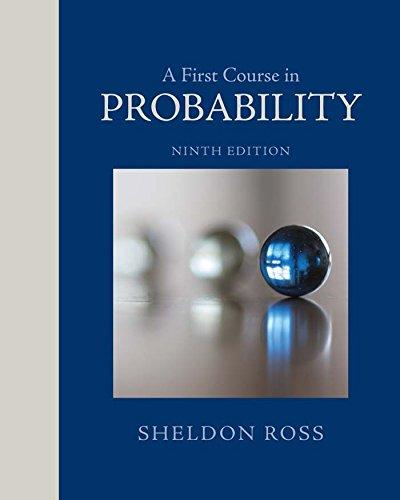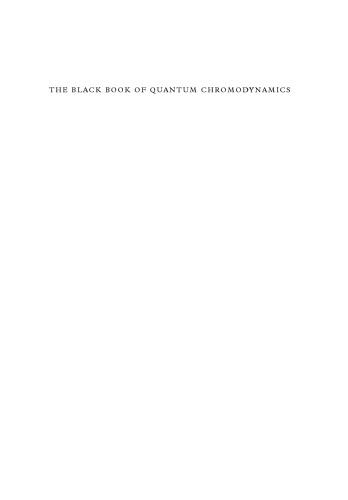Models of Quantum matter : a first course on integrability and the Bethe Ansatz First Edition. Edition Eckle
Visit to download the full and correct content document: https://ebookmass.com/product/models-of-quantum-matter-a-first-course-on-integrabil ity-and-the-bethe-ansatz-first-edition-edition-eckle/
More products digital (pdf, epub, mobi) instant download maybe you interests ...
An Introduction to quantum optics and quantum fluctuations First Edition. Edition Milonni
https://ebookmass.com/product/an-introduction-to-quantum-opticsand-quantum-fluctuations-first-edition-edition-milonni/
Integrability: From Statistical Systems to Gauge Theory First Edition. Edition Patrick Dorey
https://ebookmass.com/product/integrability-from-statisticalsystems-to-gauge-theory-first-edition-edition-patrick-dorey/
A First Course in Probability 9th Edition, (Ebook PDF)
https://ebookmass.com/product/a-first-course-in-probability-9thedition-ebook-pdf/
A First Course in Abstract Algebra, 7th Edition
Fraleigh
https://ebookmass.com/product/a-first-course-in-abstractalgebra-7th-edition-fraleigh/
The black book of quantum chromodynamics : a primer for the LHC era First Edition. Edition Campbell
https://ebookmass.com/product/the-black-book-of-quantumchromodynamics-a-primer-for-the-lhc-era-first-edition-editioncampbell/
A First Course in the Finite Element Method 6 Enhanced SI Edition Daryl L. Logan
https://ebookmass.com/product/a-first-course-in-the-finiteelement-method-6-enhanced-si-edition-daryl-l-logan/
On Law and Justice First Edition Alf Ross
https://ebookmass.com/product/on-law-and-justice-first-editionalf-ross/
Essays on Frege’s : basic laws of arithmetic First Edition. Edition Ebert
https://ebookmass.com/product/essays-on-freges-basic-laws-ofarithmetic-first-edition-edition-ebert/
Oxford Mathematics: Applications and Interpretation
Higher Level Course Companion First Edition David Harris
https://ebookmass.com/product/oxford-mathematics-applicationsand-interpretation-higher-level-course-companion-first-editiondavid-harris/
MODELSOFQUANTUMMATTER ModelsofQuantumMatter AFirstCourseonIntegrabilityandtheBetheAnsatz Hans-PeterEckle
HumboldtStudyCentre UlmUniversity
GreatClarendonStreet,Oxford,OX26DP, UnitedKingdom
OxfordUniversityPressisadepartmentoftheUniversityofOxford. ItfurtherstheUniversity’sobjectiveofexcellenceinresearch,scholarship, andeducationbypublishingworldwide.Oxfordisaregisteredtrademarkof OxfordUniversityPressintheUKandincertainothercountries ©Hans-PeterEckle2019
Themoralrightsoftheauthorhavebeenasserted
FirstEditionpublishedin2019
Impression:1
Allrightsreserved.Nopartofthispublicationmaybereproduced,storedin aretrievalsystem,ortransmitted,inanyformorbyanymeans,withoutthe priorpermissioninwritingofOxfordUniversityPress,orasexpresslypermitted bylaw,bylicenceorundertermsagreedwiththeappropriatereprographics rightsorganization.Enquiriesconcerningreproductionoutsidethescopeofthe aboveshouldbesenttotheRightsDepartment,OxfordUniversityPress,atthe addressabove
Youmustnotcirculatethisworkinanyotherform andyoumustimposethissameconditiononanyacquirer PublishedintheUnitedStatesofAmericabyOxfordUniversityPress 198MadisonAvenue,NewYork,NY10016,UnitedStatesofAmerica
BritishLibraryCataloguinginPublicationData Dataavailable
LibraryofCongressControlNumber:2019930263
ISBN978–0–19–967883–9
DOI:10.1093/oso/9780199678839.001.0001
Printedandboundby CPIGroup(UK)Ltd,Croydon,CR04YY LinkstothirdpartywebsitesareprovidedbyOxfordingoodfaithand forinformationonly.Oxforddisclaimsanyresponsibilityforthematerials containedinanythirdpartywebsitereferencedinthiswork.
FürIrene
Preface WhystudyBetheansatz?TheBetheansatzprovidesoneoftheveryfewmethodologiesto calculatethephysicalpropertiesofmodelsforstronglyinteractingquantummatter non–perturbatively.Arguablyitistheonlysuchmethodwehavewhichisexact.Thismeans, oncewehavesetupthemodel,therearenoapproximationsorfurtherassumptions necessary:wecanexactlycomputephysicallyrelevantpropertiesofthemodel.Thereis, furthermore,aninfinitesetofconservedquantities:thequantummechanicalmodelis integrable.
Thismakesthesearchforquantummodelswhichareamenabletoanexactsolutionby theBetheansatzmethodologysoimportantandrewarding.Evenif—asissometimes,but certainly notalways,thecase—themodelwithanexactsolutionisnotthemostphysically relevantone,theexactsolutionwillprovideimportantbenchmarksforothermodelsthat mayoccasionallybeclosertophysicalreality,butdonotadmitanexactsolution.Hence, foraplethoraofcases,theBetheansatzsolutionprovidesvaluableinsightintothephysics ofstronglyinteractingquantummatter.
SinceHansBetheprovidedtheeponymousmethodtosolvetheHeisenbergquantum spinchain,manymoremodelsoflow-dimensionalquantumsystemshavebeenfoundto beintegrablebytheBetheansatz.
Moreover,thesemodelsandtheirintegrabilityhavebeenandcontinuetoplayaninfluentialroleinmanysubfieldsofphysics,whichincludeclassicalandquantumstatistical mechanics,quantumfieldtheory,andquantummany-particleandcondensedmatter physics,thelatterinrecenttimesespeciallyinconnectionwithmoderndevelopmentsin physicsonthenanometrescaleandinlowdimensions.Quantumopticshasalsobenefited fromstudyingintegrablemodels,especiallyininvestigationsofultracoldBosonicand FermionicquantumgasesandBose–Einsteincondensatesinartificialcrystalsoflight, theso-calledopticallattices.Recentlyinstringtheoryandcosmologythereisahype ofactivityinvolvingconjecturesofBetheansatzintegrabilityintheframeworkofthe celebratedanti-de-Sitterspace/conformalfieldtheory(AdS/CFT)correspondence.
Ofcourse,BetheansatzandintegrabilityarediscussedinMathematicalPhysics,but thereisalsoanongoingcross-fertilizationwithvarioussubfieldsofpureMathematics.
Someprominentexamplesofintegrablemodelsinclude:variousvariantsofthe Heisenbergquantumspinchainwhosephysicalrealizationsareprobedbyneutron scattering;theHubbardmodelanditsvariantswhichinteraliahavebeendiscussed inconnectionwithhigh-temperaturesuperconductivity;theKondomodelwhichhas recentlyseenarenaissancebecauseofthedevelopmentoftunablequantumdots; interactingBoseandFermigaseswhichcannowbeproducedinverypureandtunable forminopticallattices.
But,whatistheBetheansatz?Initsoriginalform,devisedbyBethe,itisaningeniously guessedformforthewavefunctionofaone-dimensionalquantumsystem.However, whythiswavefunctioniscorrectandevenexactremainedanopenquestionwhichhas onlybeenansweredmuchlaterthroughthealgebraicformoftheBetheansatz.This methodenablesustoconstructanintegrablequantummodelinonedimensionfrom atwo-dimensionalstatisticalmechanicalmodel.Theconstructionrevealsthereason forquantumintegrabilityanddeliverstheinfinitesetofconservedquantitiestogether withthewavefunctionwhichBetheguessed.InourexpositionoftheBetheansatz methodology,weshallthereforestart,somewhatunhistorically,butmoresystematically, withthealgebraicBetheansatz.
Whoisthisbookfor?Interestingly,alookatRichardFeynman’slastblackboards(Paz, 1989)revealsthathemaywellhavebeeninterested.Inoneofhislastpublications(1988), Feynmaninfactwrote:
‘Igotreallyfascinatedbythese(1 + 1)-dimensionalmodelsthataresolvedbytheBethe ansatzandhowmysteriouslytheyjumpoutatyouandworkandyoudon’tknowwhy.I amtryingtounderstandallthisbetter.’CitedafterBatchelor(2007).
InviewoftheexcitingdevelopmentsinBetheansatzofthelasttwodecades,Richard Feynman’sfascinationwouldcertainlyhavecontinued.
Themosthelpfulprerequisitesforpresentreadersareagoodgroundinginquantum mechanics,statisticalmechanics,andthebasicsofquantummany-particletheory, especiallysecondquantization.However,weshallcomprehensivelydiscussthenecessary toolsandbackgroundinpartIofthebook.Throughthisapproach,thebookshould besmoothlyaccessibleforMaster’sstudentswholookforanareaofspecializationas wellasforbeginninggraduatestudents.Moreover,toparaphrasePaulHalmos(inthe prefaceofhisbookonMeasureTheory(Halmos,1978)),thenovicetotheBetheansatz methodologyshould not bediscouragedifsheorhefindsthatsheorhedoesnothavethe prerequisitestoreadthepreliminaries.Afterall,asMaxBornremindsus,wherewould quantumphysicsbeifWernerHeisenberghadbeendiscouragedthathedidnotknow whatamatrixwaswhenhedevelopedthematrixformofquantummechanics?
Thebookgrewoutoflecturenotestheauthorpreparedforaninvitedgraduatelecture seriesattheIndianInstituteofScienceinBangalorein1995,summerschoolcourses attheUniversityofJyväskyläinCentralFinlandin1997(on BetheAnsatzMethodsin Many–BodyPhysics)and1999(on ConformalInvarianceinStatisticalPhysics),agraduate courseatthesameUniversitywhich,togetherwithanamiablegroupofstudents, madetheextremelycoldFinnishwinterof1999actuallyanenjoyableexperience,and postgraduatecoursesattheUniversityofNewSouthWalesinSydneyin2000,and withintheMathematics–Physics MP 2 PlatformatGöteborgUniversityin2009,aswell assummerschoollecturesinTurkey:2013inTurunç,2014inIzmirand2013inIreland inDungarvenundertheauspicesoftheSchoolofTheoreticalPhysicsoftheDublin InstituteforAdvancedStudies.
Acknowledgements Theauthor’s workingknowledge ofthetopicsandmethodsonwhichthisbookfocuses wasshapedthroughcollaborationswithseveralpeoplewhoaregratefullyacknowledged inchronologicalorder:FerencWoynarovich,TuongTruong,ChrisHamer,Rudolf Römer,BillSutherland,AlexanderPunnoose,HenrikJohannesson,CharlesStafford, TimByrnes,RobertBursill,AndersSandvik,andJohanNilsson.Gratefullyacknowledgingdiscussionswithmanyothers,especiallymythesisadvisorDieterSchotteand withIngoPeschelandKarolPenson,Ishallnotattempttomentionallofthemforfear thatsomeone’snamemightescapemyattention.
IlearnedcoordinateBetheansatzfromandduringafruitfulcollaborationwithFerenc Woynarovich.WebothwereinitiatedtothealgebraicBetheansatzbyTuongTruong.
IalsooftenenjoyedstimulatingdiscussionswithHolgerFrahmaswellasmutualvisits withFabianEssler,AndreasKl ¨ umper,andAndreasSchadschneider.
MydeeplyfeltthanksgotoHenrikJohannessonforhiskindinvitationstoprepareand deliverlecturesinGöteborgand,veryespecially,forourlong-standingcollaborationand friendship.
GreatthanksarealsoduetoHenrikagainandAlexanderStolinfororganizing andco–lecturingthecourseon‘IntegrableModelsandQuantumGroups’withinthe Mathematics–Physics MP 2 PlatformatGöteborgUniversity.
JussiTimonen’sinitiativeishighlyappreciatedforsuggestingandencouragingmy lecturesinJyväskylä.
ValuablediscussionswithBalazsHetényi,especiallyinconnectionwiththecoorganizationofthesummerschoolsinTurkey,andwithDanielBraak,aregratefully acknowledged.ManythanksalsogotoKarstenSeifertwhovolunteeredtoundertake thealtruistictaskofproof-readingpartsofthisbookatvariousstagesofitsformation.
ManythanksareduetoNatanAndrei,NikolayBogoliubov,andthelateAnatoli IzerginfortheirhospitalityatRutgersandinSanktPetersburg,respectively,andthe sharingoftheirknowledgeinstimulatingpersonaldiscussionsandinthewrittenform oflecturenotes,andalsotoVladimirKorepinforencouragementonmanyoccasions.
ManythanksarealsoduetoPeterHorsch,JoachimStolze,andJohannesVoit,and thelateHeinzBarentzenandHellmutKeiterfordiscussionsandhospitalityinStuttgart, Bayreuth,andDortmund,respectively,andthesharingofpertinentsetsoflecturenotes.
TheteamatOxfordUniversityPresscannotbepraisedhighlyenough,especiallytheir friendlypatienceandcheerfulspirit,whichappeartobeinexhaustible.Theincentiveof AprilWarmangotthisprojectunderwayandhelpeditalonginitsearlyinfantsteps. SönkeAdlungsuppliedfreshguidancetohelptheprojectalongwheneverthereseemed tobeanimpasse.AniaWronksinevertiredofprovidingmotivationandmomentumfor thebookprojectand,ofcourse,allthenecessaryinformation.
1Introduction 1
Part1MethodsandModelsintheTheoryofQuantumMatter
2QuantumMany-ParticleSystemsandSecondQuantization 5
2.1Many-particleHilbertspaces8
2.2Occupationnumberrepresentation:BosonsandFermions19
2.3CreationandannihilationoperatorsforBosons21
2.4Basistransformation26
2.5Quantumfieldoperators27
2.6One-particleoperators29
2.7Two-particleoperators33
2.8SecondquantizationoftheSchrödingerequation:Bosoniccase35
2.9CreationandannihilationoperatorsforFermions36
2.10SecondquantizationoftheSchrödingerequation:Fermioniccase40
2.11Secondquantizationformalismandthemany-particlewavefunction41
2.12Normalordering43
3AngularMomentum 45
3.1Angularmomentumofasinglequantumparticle45
3.2Angularmomentumofseveralquantumparticles56
4EquilibriumStatisticalMechanics 63
4.1Fundamentalpostulateofequilibriumstatisticalmechanics64
4.2Microcanonicalensemble66
4.3Entropy67
4.4Secondlawofthermodynamics68
4.5Temperature69
4.6Pressureandchemicalpotential69
4.7Firstlawofthermodynamics70
4.8Canonicalensemble70
4.9Partitionfunction72
4.10Grandcanonicalensemble75
4.11Gibbsentropy77
4.12Densitymatrix78
4.13Non-interactingquantumgases82
4.14Classicallatticemodelsinstatisticalmechanics93
4.15Interactingmagneticmoments:mean-fieldtheory97
4.16Transfermatrix106
4.17Exactsolutionoftheone-dimensionalIsingmodel108
5PhaseTransitions,CriticalPhenomena,andFinite-SizeScaling 111
5.1Phases,phasediagrams,andphasetransition113
5.2Criticalbehaviour116
5.3Landau–Ginzburgtheory120
5.4Scaling126
5.5Renormalizationgroup131
5.6Finite-sizescaling147
5.7Quantumphasetransitions154
6StatisticalMechanicsandQuantumFieldTheory 177
6.1Connectionbetweenstatisticalmechanicsandquantumfieldtheory177
6.2Thermalfluctuationsandquantumfluctuations181
7ConformalSymmetryinStatisticalMechanics 188
7.1Fromscaletoconformalinvariance189
7.2Conformalsymmetry194
7.3Conformaltransformationsindimensionslargerthantwo195
7.4Conformaltransformationsintwodimensions202
7.5Orderparameterfieldsandcorrelationfunctions205
7.6Energy-momentumtensor209
7.7Energy-momentumtensorintwodimensions212
7.8ConformalWardidentities213
7.9Energy-momentumtensorandtheVirasoroalgebra218
7.10Finite-sizecorrectionsrevisited234
8ModelsofStronglyInteractingQuantumMatter 241
8.1Bosefluid242
8.2Electroniccorrelations255
8.3Coulombgas269
8.4LandauFermiliquidtheory278
8.5Luttingerliquidtheory289
8.6Magnetism313
8.7Hubbardmodel356
8.8Heisenbergmodel366
8.9Magneticquantumimpuritymodels372
8.10QuantumRabimodel395
Part2AlgebraicBetheAnsatz
9IceModel 425
9.1Physicalmotivationforthesquarelatticeicemodel425 9.2Definitionoftheicemodel428
10GeneralSquareLatticeVertexModels
430
10.1Vertexmodelsintwodimensions432 10.2Sixteen-andeight-vertexmodels432 10.3VertexBoltzmannweightsandthepartitionfunction432 10.4R-matrix:matrixofBoltzmannweightsofavertex434 10.5Integrabilityandthetransfermatrix438 10.6Commutingtransfermatrices438
10.7Monodromymatrix440 10.8FurthertotheL-operator446 10.9Yang–Baxterrelations447 10.10MoreonYang–Baxterrelations449 10.11ExploitingYang–Baxterintegrability451
11Six-VertexModel 454
11.1Yang–Baxterrelationforthesix-vertexmodel455 11.2Parameterizationofthesix-vertexmodel456 11.3AlgebraicBetheansatzsolutionofthesix-vertexmodel459 11.4QuantumHamiltoniansfromthetransfermatrix467 11.5InhomogeneousYang–Baxterquantumintegrablemodels470
12QuantumTavis–CummingsModel
12.1AlgebraicBetheansatzrevisited474 12.2ModifiedquantumTavis–Cummingsmodel475
12.3TransfermatrixofthemodifiedquantumTavis–Cummingsmodel476 12.4Commutativityofthetransfermatrix479 12.5SimplequantumTavis–Cummingsmodel481 12.6BetheansatzsolutionofthequantumTavis–Cummingsmodel484
Part3CoordinateBetheAnsatz 13TheAnisotropicHeisenbergQuantumSpinChain 491
13.1DescriptionoftheXXZHeisenbergquantumspinchain492 13.2SpecialcasesoftheXXZHeisenbergquantumspinchain495 13.3BasicpropertiesoftheXXZHeisenbergquantumspinchain498
14BetheAnsatzfortheAnisotropicHeisenbergQuantumSpinChain 502 14.1VerificationoftheBetheansatz503 14.2Periodicboundaryconditions508 14.3Parameterizationofthequasi-momenta511
14.4GroundstateoftheXXZHeisenbergquantumspinchain517 14.5ExcitationsoftheXXZHeisenbergquantumspinchain522 14.6Excitationsoftheisotropicantiferromagneticspinchain537
15BoseGasinOneDimension:Lieb–LinigerModel 545
15.1Classicalnon-linearSchrödingerequation546 15.2Quantumnon-linearSchrödingermodel547
15.3Lieb–Linigermodelinthehardcorelimit:gas549
15.4 δ -potentialasboundarycondition552
15.5FormoftheBetheeigenfunctions553 15.6ConstructionoftheBetheansatzwavefunction558 15.7Unrestrictedconfigurationspace562
15.8Periodicboundaryconditions:Betheansatzequations565
15.9Groundstateofthe δ -Bosegasinthethermodynamiclimit568 15.10Excitedstates573
Part4ElectronicSystems:NestedBetheAnsatz 16ElectronicSystems 585
16.1Fermigasinonedimension586 16.2One-dimensionalHubbardmodel598 16.3Kondomodel600
16.4AlgebraicBetheansatzforthespineigenvalueproblem612 16.5Magneticimpuritiesinnanostructures:Betheansatzresults625
Part5ThermodynamicBetheAnsatz 17ThermodynamicsoftheRepulsiveLieb–LinigerModel 633
17.1Thermodynamiclimit,particles,andholes633 17.2Betheansatzequationsforparticlesandholes634 17.3EntropyandthermodynamicBetheansatz636
18ThermodynamicsoftheIsotropicHeisenbergQuantumSpinChain 641
18.1SummaryofBetheansatzfortheisotropicspinchain641 18.2PreparationofthethermodynamicBetheansatz:particlesandholes644
18.3ThermodynamicBetheansatzequations649
18.4Thermodynamics652
18.5Thermodynamicsforsmall T and h 653
Part6BetheAnsatzforFiniteSystems 19MathematicalTools 657
19.1Euler–Maclaurinformula657
19.2Wiener–Hopftechnique661
20.1BetheansatzforthefiniteHeisenbergquantumspinchain668
20.2Finite-sizecorrections669
20.3ApplicationoftheEuler–Maclaurinformula673
20.4ApplicationoftheWiener–Hopftechnique675
20.5Higherorderfinite-sizecorrections685 References
Ajourneyofathousandmilesbeginswithasinglestep.
–LaoTzu
Thisbriefintroductorychapter’spurposeistodirectyou,thereader,quicklytothose placesinthebookwhereyoucanfindgeneralintroductoryinformationthatmaybe helpfulforanoverviewofandtheorientationwithinthebook.Itisdeliberatelykept shorttoavoidredundancies.
Thegeneralmotivationforthewritingofthebookandthemaintargetedreaderships aswellasthelevelsofsophisticationassumedanddetailaimedatinthepresentation ofthevariouspartsofthebookareoutlinedinthepreface.There,wealsoattempta delineationofanassessmentoftherelevanceofthebook’stopicsforcurrentandpotential futureresearch.
Thelistofcontents,byitsnatureintheformofkeywordsandkeyphrases,provides amorecomprehensiveorientationofallthetopicstreatedandtheirmutualdependence.
Thebookisdividedintosixmajorpartsand,includingthisshortintroductorychapter, intotwentychapters.Eachpartandeachchapterbeginswithadescriptiondetailing theirrespectivesubjectmatter.Thepartdescriptionssupplythebiggerpicture,whilethe outlinesatthebeginningsofeachchapterpointmorespecificallytothetopicstreated. Whereverthisseemedtobehelpful,wehaveattemptedtosupplyfurthersignpostsabout whatwehaveachievedandwhereweplantogofromthere.
Atvariousplaces,wealsoremarkonthedepthwithwhichthetopicsaretreated,what mayhavebeenleftoutorwillonlybementionedinpassing,therelationtootherparts andchaptersandthebook’sintentionsasawhole,andwheretofindalternativeand furtherspecializedtreatmentsofthesetopics.
Inordertosupplyaroughoverview,letusbrieflysummarizethemajorpartsofthe bookandtheirinterrelationship.
PartIrangesfromthefundamentalconceptsandtoolsrequiredforanunderstanding ofstronglyinteractingquantummattertothefundamentalmodelsthatrepresentthe physicalsystemsofstronglyinteractingquantummatter.Inthisbook,wewantto investigateselectedaspectsofthesemodelswithaparticularemphasisontheusesof theexactmethodologyoftheBetheansatzandofquantumintegrability.
PartIIisdevotedtothequantuminversescatteringmethodandthealgebraicBethe ansatzthatdemonstratethequantumintegrabilityofcertainone-dimensionalstrongly interactingquantummodelsandprovidetheirexactsolution.Ourapproachmakes decisiveuseoftheintimateconnectionbetweenthesemodelsandtwo-dimensional
modelsofclassicalstatisticalmechanics.Theconcretemodelsweshallbeenlistingin thispartaretheHeisenbergquantumspinchainasone-dimensionalquantummodel andthesix-vertexmodelastwo-dimensionalclassicalstatisticalmodel.
InpartIII,weintroducethecoordinateBetheansatz,theoriginalapproachBethe usedtosolvetheHeisenbergquantumspinchain.Sincethisapproachdoesnotallow ustounderstandwhythemodelsarequantumintegrable,weshalladdressitonlyafter wediscussthealgebraicBetheansatzandthequantuminversescatteringmethod.The coordinateBetheansatzapproachis,however,stillextremelyuseful.Wedemonstratethis againfortheHeisenbergquantumspinchainandalsoforagasofBosonsinteractingvia δ -functionpotentialsinonedimension.
PartIVisconcernedwithstronglyinteractingquantummodelswherethefundamentalconstituentshaveinternaldegreesoffreedom.Ourexamples,theone-dimensionalgas ofFermionsinteractingvia δ -functionpotentials,theone-dimensionalHubbardmodel, andtheKondomodelofamagneticimpurityinteractingwithconductionelectrons,are allelectronicmodelswherethereisonlyoneinternaldegreeoffreedominadditiontothe particledegreeoffreedom,whichiselectronicspin.Weshallfindthatthesemodelscan besolvedbytwointerconnectedBetheansätze.Themethodisthuscalled nested Bethe ansatz.
Thusfar,theBetheansatzmethodsdiscussedweremainlyinvestigatingthelow-lying andthereforezerotemperaturepropertiesofthequantummodels.InpartVweexamine howtoextendtheBetheansatztofinitetemperatures.Again,ourquantummodelsof choicewillbetheHeisenbergquantumspinchainandalsotheBosegasinteractingvia δ -functionpotentialsinonedimension.
InpartVI,thefinalpartofthebook,werelinquishanotherassumptionwemade orhadtomakeinordertofindsolutionsoftheBetheansatzequations,equationswhich generallyholdforafinitesystem.Sofar,weusuallyconsideredthethermodynamiclimit, thelimitofaninfinitesystemsize.ThislimitallowedustorewritetheBetheansatz equationsaslinearintegralequationsforcertaindensitieswhosesolutionscharacterized solutionsoftheBetheansatzequations,butonly,ofcourse,forthethermodynamiclimit. TheBetheansatzforfinitesystemsattemptstofindcorrectionstotheBetheansatz solutionsandphysicalquantities,e.g.thegroundstateenergyofthethermodynamiclimit thattakesintoaccountthefinitenessofasystem.Again,weinquireintohowthiscanbe achievedusingtheHeisenbergquantumspinchainasourexemplarymodelsystem.
Thefocusofthisbookisonselectedconcepts,methods,andmathematicaltechniques intheareaofstronglyinteractingquantummattersystems,especiallythevarious Betheansatztechniquesdiscussed.Wehopethatthesetechniqueswillproveuseful infutureresearchintheareaofstronglyinteractingquantummatter.Wealsohope thatsomephysicalinsightwillbegainedfromthemodelsofquantummatterusedas examplestodemonstratetheconceptsandtechniquesandwillprovideguidanceforthe understandingofothersystemsnottreatedhere.
Forthemostpart,weshallusenaturalunitswherethespeedoflight,Boltzmann’s, andPlanck’sconstantsare
exceptwhenincludingtheconstantsexplicitlywillrendertheresultsmoretransparent.
Part1 MethodsandModelsinthe TheoryofQuantumMatter Cannotwebecontentwithexperimentalone?No,thatisimpossible;thatwouldbea completemisunderstandingofthetruecharacterofscience.Themanofsciencemust workwithmethod.Scienceisbuiltupoffacts,asahouseisbuiltofstones;butan accumulationoffactsisnomoreasciencethanaheapofstonesisahouse.
–HenriPoincaré(1854–1912)
Thisfirstpartofthebookpresentsanoverviewofthemostimportantmethods indispensableforanunderstandingofthetheoryofstronglyinteractingquantummatter. Moreover,weintroduceaselectionofquantummechanicalmany-particlemodelsand therelatedconceptsthatformthebackgroundofthetheoryofquantummatter, especiallyinviewofthequantumintegrablemodels,whoseexactBetheansatzsolutions arediscussedinlaterpartsofthebook.Thesemethodsandmodelsarerelevantalsoin manyotherpartsoftheoreticalandmathematicalphysics.Itisthereforerecommended thatreadersreviewthismaterialtojudgehowfamiliartheyarewithit.
Thesechapters,however,donottreatanddonotattempttotreattheirtopicsinafully comprehensivemanner.Thereisalwaysalotmorethatcouldbecovered.Infact,there isavastliteraturespecificallydevotedtothesetopics.Nevertheless,weattemptasclear andcomprehensibleatreatmentaspossibleoftheaspectswecoverwiththeintentionto renderthoseaspectsthatwedocoverself-contained.Whereaself-containedtreatmentis beyondthelimitationsofthisbook,weprovideappropriatehintstotheliteraturespecially devotedtothesetopics.
Morespecifically,inchapter2,basicfactsarereviewedfromthequantummechanics ofmany-particlesystems,inparticularleadingfromtheHilbertspacesrepresenting quantummany-particlesystemstoadiscussionofsecondquantization,whichisthe languagemostusefultoformulatethemodelsofstronglyinteractingquantummatter.
Moreover,inchapter3weaddressthequantummechanicaltheoryofangular momentum,especiallyformanyquantumparticles,whichisindispensableforan understandingofthemagneticpropertiesofthemodelsofstronglyinteractingquantum
MethodsandModelsintheTheoryofQuantumMatter
matter.Thesemagneticpropertieswillbeatthecentreofmuchofourdiscussionof quantumintegrablemodelsandtheirexactBetheansatzsolutions.
Quantummany-particletheoryis,ofcourse,restingonthefoundationsofequilibrium statisticalmechanics,especiallyquantumstatisticalmechanics.Butclassicalstatistical mechanicsalsowillbenecessarytoappreciatethedevelopmentsofquantummodels thatareintegrablebytheBetheansatzmethod.Anexaminationofthemethodsand resultsofequilibriumstatisticalmechanics,bothclassicalandquantum,willthereforebe ausefuladditioninthisfirstpartofthebook,andwhichwetakeupinchapter4.
Amongthemostfascinatingphenomenaofmany-particlesystems,againclassical andquantum,phasetransitionsandcriticalphenomenaoccupyaprominentplace. Theirtheoreticaldescriptionischallengingandrequiresanarsenalofsophisticatedand innovativemethodsthatareoutlinedinchapter5,wherewealsoanalysetheapproach tothethermodynamiclimitofsystemsoffinitesize.
Thereisanintimateconnectionbetweenquantumfieldtheoryand(classical)statisticalmechanicsonwhichmuchofthequantuminversescatteringmethodandthe algebraicBetheansatzisfounded.Chapter6offersanintroductiontothisimmensely usefulconnection,whichwillalsoplayacentralroleinthesubsequentchapter.
Betheansatzcalculationsforfinitesystems,beingrathermoreinvolvedthanthosein thethermodynamiclimit,produceresultsthatcanbedirectlycomparedtopredictions basedontheconformalsymmetryoftwo-dimensionalclassicalstatisticalmechanics. Inordertofullyappreciatethisconnection,chapter7offersanintroductionintobasic aspectsoftheconformalsymmetryofcriticalsystems.
Whilethechaptersdescribedsofarweremainlyconcernedwithmethodsusefulfor athoroughappreciationoftheBetheansatzmethodologiesexaminedinlaterpartsof thebook,chapter8ofthisfirstpartintroducesthephysicalbackgroundofaselectionof modelsofstronglyinteractingquantummattertogetherwithmethodstoinvestigateand understandthem.Theselectioncriteriahavebeenwhetherappropriateversionsofthe modelsexhibitquantumintegrabilityandaresolvablebyBetheansatz.Thequantum many-particlemodelsconsideredrangefromtheBosefluidtomodelsofitinerantas wellaslocalizedmagnetismandtotheFermiliquidandultimatelytomodelsofstrong light–matterinteraction.
QuantumMany-ParticleSystems andSecondQuantization Oneoftheprincipalobjectsoftheoreticalresearchistofindthepointofviewfrom whichthesubjectappearsinthegreatestsimplicity.
JosiahWillardGibbs(1839–1903)
Thischapterreviewssomeaspectsofthequantummechanicsofsystemscomposedof manyparticles(many-bodyormany-particlesystems),whichwillproveusefulforthe laterdevelopmentsinthisbook.Wemainlyconcentrateonthefoundationsofquantum many-particlephysicsleadingtotheformalismof secondquantization asaconvenient languagefortheformulationofthepropertiesofthemany-particlesystemsofquantum matter.
Many-particlequantumsystemscanbedescribedbyamany-particleSchrödinger equation,whosecorrespondingwavefunctiondependsontheconfigurationofthe particles,e.g.theirpositions ri andpossiblyfurtherquantumnumbers,e.g.thespin quantumnumbers σ i oftheparticles.Inpracticethisapproachisverycumbersomeeven forquitemodestnumbersofparticles,letaloneforthemacroscopicnumbersofparticles ofquantumstatisticalmechanicsandcondensedmatterphysics. Secondquantization is aformulationorlanguageofmany-particlequantummechanicsthathelpstominimize thetechnicalcomplicationsofpracticalcalculationsformany-particlesystems.
Itisalsotheappropriatelanguageofotherbranchesoftheoreticalphysics,most notablyquantumfieldtheory(see,forexampleLancasterandBlundell,2014).
Twoexamplesillustratetheusefulnessofsecondquantization.Inquantumfield theoryaswellasmanyapplicationsofmany-particlephysicsandcondensedmatter physics,thenumberofparticlesisvariable,i.e.particlescanbecreatedaswellas destroyed.1 Moreover,theSchrödingerequation,andhencethewavefunction,fora
1 Asweshallsee,theconceptofcreatingandannihilatingparticlesisaratherabstractone,especiallyfor Fermions,i.e.particlesforwhichthePauliexclusionprincipleapplies.RichardFeynman,inhisNobelprize acceptancespeech(Feynman,1965),alludestothisinapersonalreminiscence:‘Irememberthatwhensomeone hadstartedtoteachmeaboutcreationandannihilationoperators,thatthisoperatorcreatesanelectron,Isaid, “howdoyoucreateanelectron?Itdisagreeswiththeconservationofcharge”,andinthatway,Iblockedmy mindfromlearningaverypracticalschemeofcalculation.’
QuantumMany-ParticleSystemsandSecondQuantization
systemof N = 1024 particlesisdifferentfromthoseofasystemof N = 1024 1particles. Yet,weexpectbothsystemstoexhibitthesamemacroscopicphysics.Inthelanguageof secondquantization,whichisspecificallyadaptedtoaccommodatevariablenumbersof particles,wecancopeeasilywithbothsituationsasdetailedworkinthischapterandin chapter4onequilibriumstatisticalmechanicsshows,aswellasthroughoutmanyother chaptersofthisbook.
Secondquantizationisastandardtopicofquantummany-particletheoryand treatmentscanbefoundinmanybookswhollyorpartlydevotedtothistopic.A classicreferencedevotedtothemethodofsecondquantizationisBerezin(1966).Some standardreferencesarethecorrespondingchaptersofAbrikosov etal. (1975),Fetter andWalecka(2003),Mahan(2000),andNegeleandOrland(1998).Morerecentwork includesNazarovandDanon(2013),AltlandandSimons(2010),andColeman(2015). Ofcourse,alloftheseworkstreatmanymoretopicsinthetheoryofquantummanyparticlephysics.
Inparticular,applicationsofthemethodofsecondquantizationcanbefoundin thecitedworksandinlaterchaptersofthisbook,whereweshallmakeampleuseof thelanguageofsecondquantization.Inthischapter,however,weconcentrateonthe formalism,demonstratingitspowerwithonlyafewelementaryexamples.
Section2.1ofthischapterconstructstheHilbertspaces,thetensorproductspaces, andtheFockspaces,appropriateforthestatesofthemany-particlesystemandthen section2.2,selectsfromtheseHilbertspacesthesymmetrizedmany-particlestatesof themany-particleHilbertspacethatdescribeBosons,whereanynumberofparticles canoccupythesamequantumstateandtheantisymmetrizedmany-particlestatesthat describeFermions,whereatmostoneparticlecanoccupythesamequantumstate.
ThisconstructionofHilbertspacesismoregeneral:foranyquantumsystemcomposedofsubsystems,aHilbertspacecanbeconstructedinthewaywedescribe. Therefore,weinitiallykeepthediscussionmoregeneralbeforewefocusagainonHilbert spacescomposedof(many)quantumparticles.
Forthefollowingfewsections,wefocusontheBosoniccase,beforeeventuallyalso discussingFermions.Insection2.3,weintroducecreationandannihilationoperators forBosons.Theseoperatorsarethemainobjectsinwhichtheformalismofsecond quantizationisexpressed.
Thecreationandannihilationoperatorscanbeexpressedindifferentorthonormal andcompletebases.Thetransformationsofthecreationandannihilationoperators betweendifferentabstractorthonormalandcompletebasesarederivedinsection2.4, whileinsection2.5thecreationandannihilationoperatorsinthepositionbasis,then calledquantumfieldoperators,areintroducedasoneofthemostimportantexamples.
Section2.6isdevotedtotheintroductionofone-particleoperators,section2.7to two-particleoperatorsintheformalismofsecondquantization.
Anelementaryintroductionofsecondquantizationstartsfromthetime-dependent single–particleSchrödingerequationofbasicquantummechanics.Howthiscanbe achievedisdemonstratedforBosonsinsection2.8andforFermionsinsection2.10.
Section2.9finallyreturnstoFermions,introducingcreationandannihilationoperatorsfortheFermioniccase.
Thepenultimatesectionofthischapter,2.11demonstratesexplicitlytheequivalence ofthemany-particlewavefunctionandtheformalismofsecondquantization,whilethe finalsection2.12ofthischaptertouchesontheissueofthecorrectorderingofcreation andannihilationoperators,i.e.thenormalordering.
Asapreludetotheformalism,westartwithanelementaryexercise:thequantum treatmentofthesingleparticleone-dimensionalharmonicoscillatorintermsofcreation andannihilationoperators,sometimesalsocalledladderoperators.Inthisexerciseweare remindedofimportantnotionsthathelpilluminatethemoreformaltreatmentoftherest ofthischapter.Moreover,thealgebraicstructureencounteredherewillreappearmany timesinthisandinlaterchapters.Hence,itmaybequiteagoodideatogothroughthis elementaryexercisetogainconfidenceforthemoreinvolvedlaterdevelopments.
EXERCISE2.1 Quantummechanicalharmonicoscillator TheHamiltonianof theone-dimensionalharmonicoscillatorofamass m andfrequency ω isgiveninterms ofthepositionoperator x andthemomentumoperator p =−i d dx satisfyingthecanonical commutationrelation
AmongthemanywaystosolvetheSchrödingerequationoftheharmonicoscillator,a particularlyelegant,andfruitful,waydeconstructstheHamiltonian(2.2)intooperators, thecreationandannihilationoperator,respectively
• Show,usingtheladderoperators a and a† ,thatthecanonicalcommutationrelation [x,p] = i becomes
andtheHamiltonian(2.2)
• Furthermore,showthat,if λ istheeigenvaluecorrespondingtothenormalized eigenstate |λ oftheoperator = a† a,then
• Calculatethecoefficients c λ and d λ
• Provethat λ ≥ 0andthat λ = 0mustbeaneigenvalue.Whatis,hence,thespectrum ofeigenvaluesof and H,respectively?Showthatthisimpliesforthegroundstate a|0 = 0.
• Usetherepresentation(2.3)oftheladderoperatorsasdifferentialoperatorsto solvetheSchrödingerequationforthegroundstatecorrespondingto λ = 0,i.e. determinethegroundstatewavefunction x|0
• Determinethewavefunctionofthefirstexcitedstatebyapplyingthecreation operator a† oncetothegroundstatewavefunction.
Theresultsobtainedthusfarsuggestthattheoperator canbeinterpretedas anoperatorcountingthenumberofexcitationsoftheharmonicoscillator.Inorder tomakethisevenmoresuggestiveletuschangethenotationandreplace by n and |λ by |n .Furthermore,asweshallseeinmoredetailinthischapter,theseresults suggestaninterpretationoftheexcitationsoftheharmonicoscillatoras particles or quasiparticles.Thestatewithnoparticles |0 thencorrespondstothevacuumstate.
• Showwiththehelpof(2.6)and(2.7)thattheproperlynormalizedstateof n excitationsor n particlesis
• Finally,toappreciatehowfruitfulthisalgebraictreatmentoftheharmonicoscillator is,calculatetheexpectationvaluesofthefirstfewpowersofthepositionoperator inthestate |n ,letussay x,x2 , x3 ,and x4 .
• Hint:Provefirstthatthenumberoperator n = a† a,andhencetheHamiltonian H = ω a† a + 1 2 ,areHermitianoperatorsandthatthereforethecorresponding eigenstates,whicharenon–degenerate(why?),areorthogonal.
Withthisexerciseatthebackofourminds,wecannowstarttodeveloptheformalism ofsecondquantizationbyfirstconstructingaHilbertspaceappropriateforaquantum many-particlesystem.
2.1Many-particleHilbertspaces Theformalismof‘secondquantization’2 providesanelegantandeconomicwayto describeaphysicalsystemcontainingagreat,possiblyindeterminate,numberof
2 Thenameisatrifleunfortunateandoriginatesfromtheinterpretationofthealgebraofladderoperators (seeexercise2.1).Theseoperatorsandtheircorrespondingquantumexcitationscanbeviewedasdiscrete ‘quantized’units.Itmustbeemphasized,however,that‘second’quantizationisarepresentationofquantum mechanicsparticularlysuitableforproblemsinvolvingmanyparticles.Itis not aquantizinganalreadyquantized theory.However,tobeabletodistinguishrepresentations,weshallinplacesalsohavetousetheequally unfortunateepithet‘first’quantization.
Many-particleHilbertspaces 9 particles.Itdescribesparticlesasquantaofaquantumfieldandis,hence,attheheart ofthemodernunderstandingofquantummechanicsandquantumfieldtheory.
Weassumethatthesolutionofthequantumproblemforoneparticleisknown,i.e. weassumethat
• thereisaone-particleHilbertspace(quantumstatespace) H1 ,with,especially,the scalarproduct φ |ψ ofstates |ψ , |φ ∈ H1 fromthisHilbertspace;
• thismeansinparticular,thattheone-particleSchrödingereigenvalueproblemhas beensolvedforthesingleparticleHamiltonian H:
where |λ ∈ H1 isanormalizedeigenstateand λ thecorrespondingeigenvalue;
• furthermore,thetimeevolutionoftheparticleisdeterminedbytheunitaryoperator (ignoringthepossibilityofanexplicitlytime-dependentHamiltonian)
• lastly,observablessuchasposition r,momentum p,angularmomentum L,etc.,of thesingleparticleproblemhavebeendetermined.
Secondquantizationisaformalismpermittingtoconstructquantitiesthatcorrespond toasystemcomposedofanarbitrary,indeterminatenumberofsuchquantumparticles undertheassumptionthatthestatementsaboveforasingleparticleholdtrue.
ThebasisoftheformalismconsistsinconstructingHilbertspacesandstatesforan arbitrarynumberofparticlesfromtheHilbertspaceandstatesofasingleparticle.
2.1.1CompositeHilbertspaceoftwosystemsAandB Asmentionedintheintroductiontothischapter,webeginwithamoregeneralpointof view.Assumethattherearetwoquantumsystems A and B whichmaybutneednotbe individualquantumparticles.Forinstance,system A coulddenoteamicroscopicsystem, whilesystem B couldrepresentamacroscopicmeasurementapparatus.Theirrespective Hilbertspacesare H A and H B .Weareinterestedinthecompositequantumsystem AB WecanconstructaHilbertspaceforthecompositequantumsystemintwodifferent ways.Bothwaysbeginbyformingaspaceofallorderedpairsofstatestakenfromthe Hilbertspaces H A and H B
whichcanbemadeintoacompositeHilbertspacebychoosingascalarproductintwo differentways.
2.1.1.1TensorproductHilbertspace
ThefirstconstructionisachievedthroughtheintroductionofatensorproductHilbert space H AB oftwoHilbertspaces H A and H B ,whosedimensionsdim H A and dim H B neednotbethesame,
withdimensiondim H AB = (dim H A )(dim H B ).WithrespecttothecompositeHilbert space H AB ,theHilbertspaces H A and H B arecalledfactorspaces.
ItshouldbeemphasizedthatalreadytheHilbertspaceofasingleparticlecanbea tensorproductspaceastheexampleofthespin-orbitHilbertspaceofasingleparticle showswhere
isthetensorproductoftheorbitalHilbertspace Horbit oftheparticlewithitstwodimensionalspinstatespace C 2
NowtheconstructionofthetensorproductHilbertspace H AB proceedsasfollows. Foreachpairofstates f A ≡|ψ A ∈ H A and f B ≡|ϕ B ∈ H
thereisa(formal) productstate F forwhichdifferentnotationsareinuse
Thesenotations,goingfromlefttoright,emphasizelessandlessthatthestatesbelong to,ingeneral,differentHilbertspaces.Hence,theiruserequiresmoreandmorecaution andaclearunderstandingoftheirmeaninginparticularsituations.
Thecompositestatesarelinearineachoftheirfactorsseparately,i.e.
withcomplexnumbers λ and μ
Thescalarproductbetweencompositestatesisformedinaspace-wisemannerby
InordertoobtainacompositeHilbertspace H AB largeenoughtocontainstatesthat cannotbewrittenaspureproductstates,i.e.statesoftheform
Many-particleHilbertspaces 11
weneedtoconsiderthelinearspan(alsocalledlinearhull)ofthespace M .Thisis achievedbytakingbasesofthefactorHilbertspaces H A and H B ,e.g. {|nA } and {|mB }, toformabasisofthecompositeHilbertspace H AB
aso-called(tensor)productbasis,inthesensethatallstatesoftheform
withcomplexnumbers cn,m asexpansioncoefficients,i.e.thelinearspanof M ,define thecompositeHilbertspace H AB . Sinceanorthonormalbasisin H AB satisfies,using(2.17),
thatis,thebasisofthecompositeHilbertspaceisorthonormalifthebasesofthefactor statesareorthonormal,weobtainforthescalarproductoftwostatesoftheform(2.20)
whichcompletestheconstructionofthecompositeHilbertspace H AB . UsingthenotionofaproductHilbertspace H AB ,wearenowinapositionto introduceinaformalwayanimportantnotionattheheartofmanyinvestigationsin quantumphysics.Itisthenotionof quantumentanglement,whichgoesbacktoimportant publicationsbyEinstein,Podolsky,andRosen1935,andespeciallybySchrödinger (1935).Acompositestatein H AB iscalledentangledifitcannotberepresentedasa productstatebutonlyasasuperpositionofproductstates,asin(2.20).
Examplesofcompositestatesthatcannotbewrittenasproductstatesaretheso-called Bellstates
whicharestatesinthecompositeHilbertspace
QuantumMany-ParticleSystemsandSecondQuantization
wherethefactorstatesdescribetwo-levelsystemsorso-calledqubits.Thesestatesare maximallyentangledstates.Detailsaboutmaximallyentangledstatesandentanglement measuresingeneralcanbefoundinAudretsch(2007).
2.1.1.2CompositeHilbertspaceasadirectsum However,adifferentwayisalsopossibletoconstructacompositeHilbertspacefromthe Hilbertspaces H A and H B ofthetwoquantumsystems A and B.Thestartingpointis againthespace M oforderedpairsofstatesgivenin(2.11).
However,nowwedefinethescalarproductoftwostates F = ( f A , f B ) ≡|ψ AB ≡ (|ψ A , |ψ B )and G = (
Thisdefinitionofascalarproductforthespace M makesitintoacompositeHilbert space ˜ H AB differentfromthetensorproductHilbertspace H AB weconstructedin theprevioussection.ThiscompositeHilbertspaceiscalledadirectsumspaceandis denoted
Inordertoavoidpossibleconfusion,wementionthatmultiplicationbyacomplex number λ istobeunderstoodcomponent-wise
incontrasttothetensorproductHilbertspace H AB where
WeencounterthisimportantkindofspacelaterunderthenameofFockspacewhen wediscusssituationsinvolvingparticleproductionanddestructionand,hence,needa Hilbertspacewithavariablenumberofparticles.
ThereweshallalsoneedthenotionoforthogonalityforstatesfromdifferentHilbert spacesthatcanbeconvenientlydefinedusingadirectsumofthesespaces.Weextend thevectors f A
Many-particleHilbertspaces
Calculatingthescalarproduct(2.26)ofthesetwospecialvectorsof H ,wediscoverthe importantresult
namely,thatstatesfromdifferentsubspacesofadirectsumHilbertspaceareorthogonal toeachother.
2.1.2Caseofmanydistinguishableparticles TheconstructionofacompositeHilbertspaceconsistingoftheHilbertspacesof twosubsystems,discussedintheprevioussection,caneasilybegeneralizedtothe caseofmanysubsystems.Fromnowonwefocusonthecaseofmanysubsystems whereeachsubsystemisasinglequantumparticle.Inconstructingthemany-particle Hilbertspace,letusassumeforthetimebeingthattheparticlesare distinguishable.Of course,inquantumphysics,weencountermanysituationswhereparticlesareindeed distinguishable,e.g.theelectronandprotonformingahydrogenatomaredistinguishable quantumparticles.
TheHilbertspaceofasystemcomposedof exactlyN particlesisgivenbythetensor productHilbertspaceof N copiesofthesingle-particleHilbertspace H1 withdimension dim H1 :
ThestatesofthisHilbertspaceareformedfromlinearcombinationsofproductstates oftheform(cp.(2.14))
Suchastatevectorrepresentsastateofthesystemwherethefirstparticleisinstate |ϕ 1 , thesecondinthestate |ϕ 2 , ,andthe N thinthestate |ϕ N .Crucially,wenotethatthe statesofdifferentparticlesmaycoincide,i.e.thatthepossibility
forparticles i = j mustbetakenintoaccount.
Thescalarproductin H ⊗N 1 isdefinedbygeneralizing(2.17)











